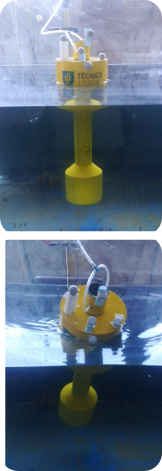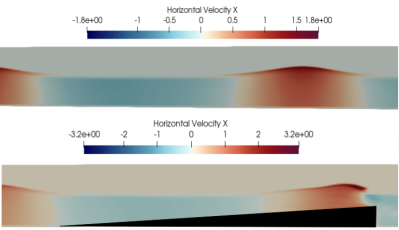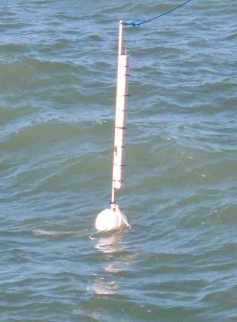Available Project Topics

AUTOMATED CFD MESH GENERATION USING MACHINE LEARNING
Traditional mesh generation and verification, involves manually creating a mesh, performing convergence studies on the discretisation level and validation against experimental data. This project will investigate an inverse approach, where the experimental data will be used to train a machine learning algorithm to produce a high quality mesh, able to reproduce the experimental data, whilst minimising the total overall cell count.

WAVES2WATER - WAVE POWERED DESALINATION
Desalination can provide access to essential clean water, however the energy requirements to drive this process are extremely high. This project will investigate aspects related to powering sea water desalination from wave energy such as: assessing the techno-economic viability of this process in different scenarios or locations, comparing wave powered desalination against other renewable energy options, modelling and optimising different wave energy converter and desalination sytem combinations and/or assessing the performance of hybrid power options, such as wave, wind, solar, diesel generator, batteries and/or electrical grid interface etc.

NOISE REDUCTION FROM OSCILLATING WATER COLUMN WAVE ENERGY CONVERTER TURBINES
“Oscillating water column” type wave energy converters, utilise an air driven turbine to generate electricity, where the air is pumped through the turbine by the action of the waves (See figure below). These types are wave energy converters are promising for incorporation into breakwater type structures, however the associated noise pollution from the turbine is a massive problem facing this concept. This project will investigate methods to reduce the noise from the oscillating water column turbine, whilst not degrading the power conversion efficiency of the system.

THERMAL ENERGY HARVESTING FOR WIRELESS SENSOR NETWORKS
Thermal energy harvesters scavenge energy from natural temperature gradients, to provide a robust power supply for autonomous wireless sensor networks in the environment. This project will involve optimising the design of the thermal energy harvesting device pictured below. The optimisation should be based on computer simulation of the system, incorporating all of the relevant physical processes (convection, conduction, radiation etc). The modelling approach should entail a combination of high fidelity simulations using CFD to provide accurate results and computationally fast simulations using AMESim/MATLAB/Python to allow many simulations to cover a wide parameter space in the design optimisation. If sufficient progress is made during the project, a physical prototype of the optimised design may be constructed and tested.

THE NEXT GENERATION OF NUMERICAL WAVE TANKS
The oceans are one of mankinid’s greatest resources, covering more than 70% of the
Earth’s surface and sustaining massive industries such as fishing, shipping, tourism, offshore oil, gas and
renewable energies. However, it is also one of the most hostile environments, presenting significant engineer-
ing challenges. Traditionally, scale model wave tank experiments were utilised for understanding, designing
and optimising systems to operate in offshore and coastal environments. However, with the continued rise
of available computing power, the ability of numerical wave tanks (NWTs) to provide value to engineers is
ever increasing. Compared to their physical counterparts, NWTs provide the following advantages: (1) can
test at full scale, eliminating scaling effects, (2) Reflections from ‘tank’ walls can be eliminated, (3) Automatic
measurement of any variable at any location, and (4) Construction of physical prototypes is not required.
Indeed a study into the economic viability of NWTs, found simulating experiments can provide comparable
accuracy whilst being economically competitive with testing in physical wave tank facilties. However, it is
still uneconomical to simulate many applications using NWTs, e.g. long durations or large domains. In
addition to the computational costs, NWTs may be too expensive for many applications due to the expert man-
hours required to setup and effectively run the simulations.
This project aims to exploit machine learning and
control techniques to reduce these costs and enhance the capabilities and affordability of NWTs.

NONLINEAR ROCK and ROLL - MODELLING AND CONTROL OF PARAMETRIC RESONANCES IN FLOATING BODIES
Parametric resonance (PR) is a nonlinear phenomenon, caused by the time-varying changes in the parameters of a system, which results in an exponential increase in oscillation amplitude. PR has been observed in floating bodies, dating back to Froude in 1861, who described large roll motion of ships occur when the roll natural period is approximately double the heave or pitch natural period. For many offshore engineering industries, such as shipping and marine renewable energy, PR causes large unwanted pitch/roll motions which are detrimental to the system performance, such as loss of cargo overboard or decreased energy production.
The goal of this project is therefore to investigate modelling, analysis and control techniques to suppress PR in floating bodies. It is a part of a larger project in collaboration with IST Lisbon and the Technical University of Denmark.
https://www.youtube.com/channel/UC2GQ7dXDDlAjkqt85xjlXJA

WAVE TRANSFORMATION AND AMPLIFICATION OVER VARIABLE BATHYMETRY
Interaction with the sea bed influences a propagating wave and can result in wave shoaling. As a wave enters shallower water, wave shoaling causes an increase in wave height and a focusing of the energy density. This project will investigate the possibility of levereging the wave shoaling effect for increased performance of a wave energy converter.

WAVE ENERGY HARVESTING FOR AUTONOMOUS SENSOR NETWORKS AT SEA
This project examines powering marine based sensors by harvesting energy from their local environment. Marine based sensor intrinsically operate in remote locations, traditionally requiring expensive maintenance expeditions for battery replacement and data download. Nowadays, modern wireless communication allows real-time data access, but adds a significant energy drain, necessitating frequent battery replacement. Harvesting renewable energy to recharge the MBSs battery, introduces the possibility of autonomous MBS operation, reducing maintenance costs and increasing their applicability. A wave energy harvester incorporated into the marine based sensor buoy should be an unobtrusive device that is easily deployable/retrievable and which can function at any deployment location regardless of the local wave climate.